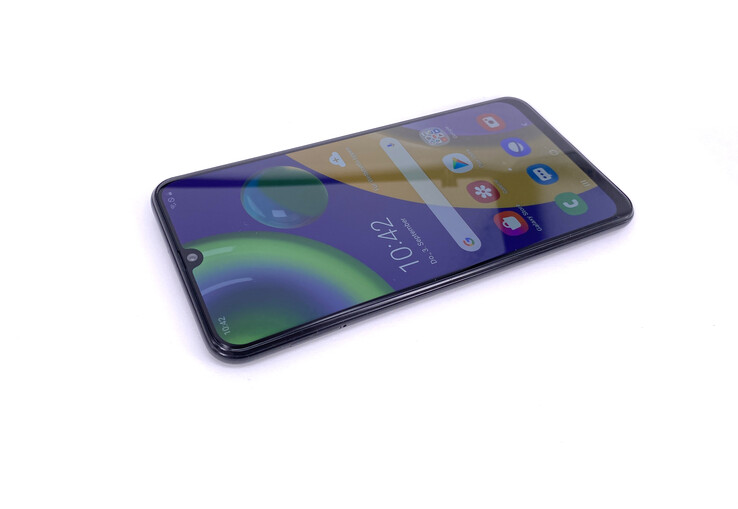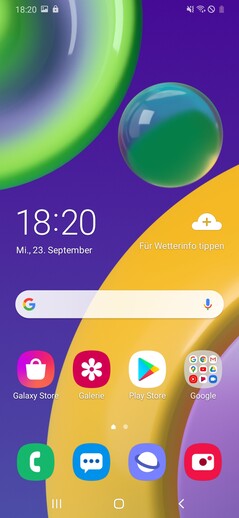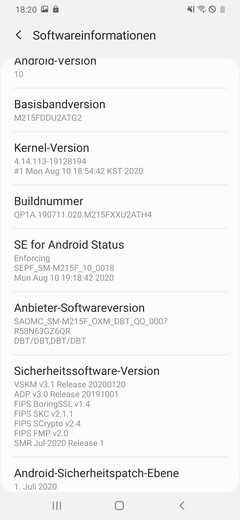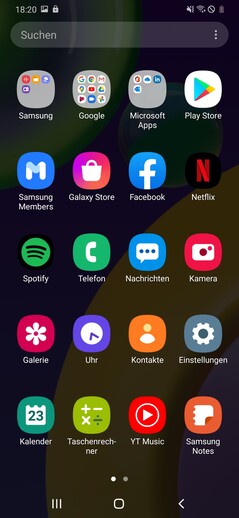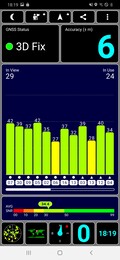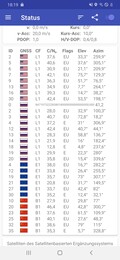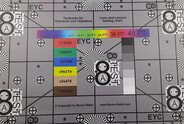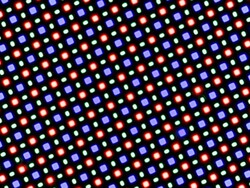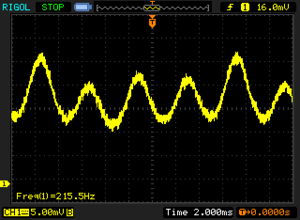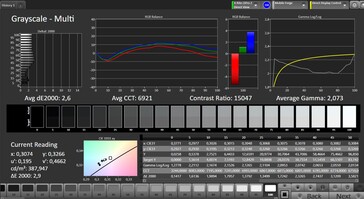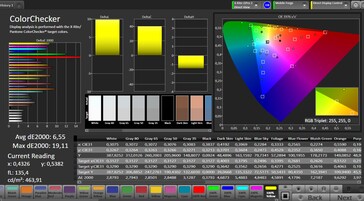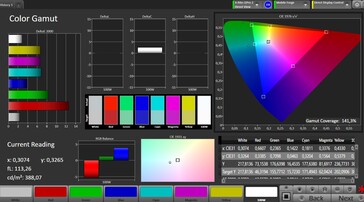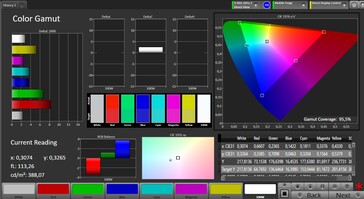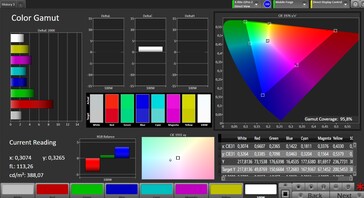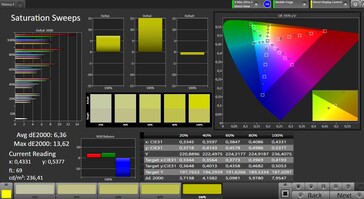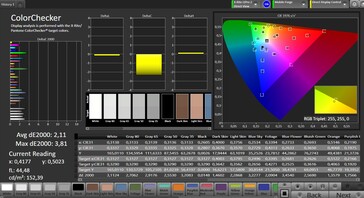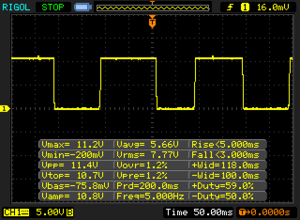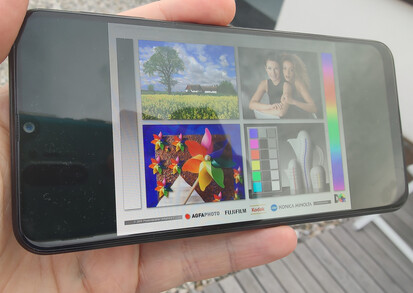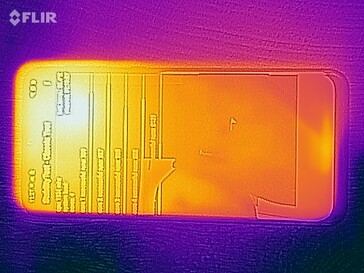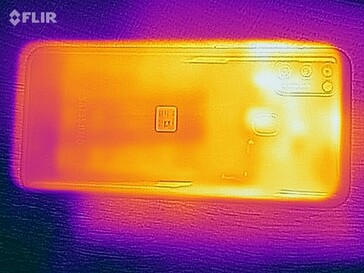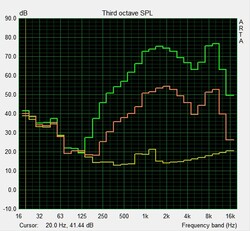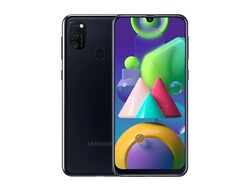Samsung Galaxy M21 Smartphone Review - Plain, but good
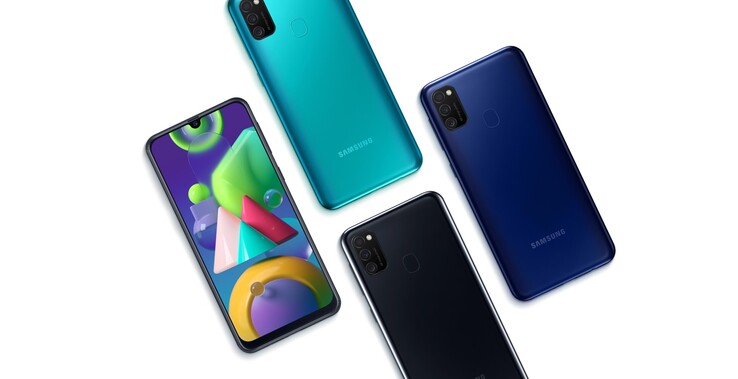
The Galaxy M series is intended for price-conscious buyers who want a usable camera and a large battery. Unlike Galaxy A series devices, the smartphones from the M series such as the Galaxy M31 and the already-released M51 are not available everywhere. However, in some cases, it might be worth it to seek these devices out. The Galaxy M21, which we are currently reviewing, is cheaper than the M31. However, the M21 offers less storage space and does not feature a macro lens, but it costs 50 Euros (~$58) less. It sounds like a good deal for those who can live with the limitations, does it not?
Comparison Devices
Rating | Date | Model | Weight | Drive | Size | Resolution | Price |
|---|---|---|---|---|---|---|---|
| 79.7 % v7 (old) | 09 / 2020 | Samsung Galaxy M21 Exynos 9611, Mali-G72 MP3 | 188 g | 64 GB UFS 2.1 Flash | 6.40" | 2340x1080 | |
| 75.1 % v7 (old) | 10 / 2020 | Sony Xperia L4 Helio P22 MT6762, PowerVR GE8320 | 178 g | 64 GB eMMC Flash | 6.20" | 1680x720 | |
| 77.3 % v7 (old) | 08 / 2020 | Oppo A72 SD 665, Adreno 610 | 192 g | 128 GB UFS 2.1 Flash | 6.50" | 2400x1080 | |
| 78.8 % v7 (old) | 06 / 2020 | Samsung Galaxy A41 Helio P65, Mali-G52 MP2 | 152 g | 64 GB eMMC Flash | 6.10" | 2400x1080 | |
| 80.7 % v7 (old) | 05 / 2020 | Xiaomi Redmi Note 9S SD 720G, Adreno 618 | 209 g | 128 GB UFS 2.0 Flash | 6.67" | 2400x1080 |
Case – Simple design, good build quality
Except for the camera system, the Galaxy M31 and the Galaxy M21 look the same. However, there is a small difference in weight. Both smartphones also come in identical colour schemes known as Black
, Blue
and Green
. Both devices feature the same plastic back, the same Gorilla Glass 3 on the front and the same tear-drop notch for the front-facing camera.
The M21 offers a very good build quality. It is very rigid. Thanks to the rounded edges, the smartphone is comfortable to hold in the hand. However, the back is still very susceptible to fingerprints.
People with small hands are going to be better off with either the Samsung Galaxy A41 or the Sony Xperia L4, because the Galaxy M21 is quite big and therefore somewhat unwieldy.
Hardware Configuration – NFC for contactless payments
The M21 comes with 4 GB of RAM and 64 GB of storage space, which is quite usual for a device in this price range. However, the UFS 2.1 memory is relatively fast. Moreover, the smartphone also has a USB Type-C port, a 3.5-mm headphone jack and an NFC chip for contactless payments.
The SIM card tray features enough space for two SIM cards and a microSD card, meaning that you can use dual SIM functionality and enjoy more storage at the same time.
Software – Android-based proprietary software
The M21 runs Android 10 with a custom launcher from Samsung known as OneUI 2.0. At the time of our review, the security patches from July, 2020 are relatively up to date. With its software, Samsung has made a concerted effort to improve one-handed operation. This is why most intractable elements are often located in the bottom half of the screen.
The M21 comes with a number of preinstalled third-party applications, some of which can only be disabled. This means that these applications will always stay on your smartphone and occupy storage space even if you do not want to use them.
Communication and Geolocation – Wi-Fi 5 with good transfer rates
The Wi-Fi 5 module in the M21 offers good data transfer rates for a device with this price tag. We conduct our Wi-Fi benchmarks using our reference-grade router Netgear Nighthawk AX12. Our review device does not support many LTE bands, which is why it is advisable to find out what LTE bands are used in each country before traveling there.
When it comes to cellular reception, the Galaxy M21 offers a mediocre level of performance. Here, competing devices do a better job, especially indoors.
| Networking | |
| iperf3 transmit AX12 | |
| Samsung Galaxy A41 | |
| Oppo A72 | |
| Samsung Galaxy M21 | |
| Xiaomi Redmi Note 9S | |
| Sony Xperia L4 | |
| iperf3 receive AX12 | |
| Samsung Galaxy A41 | |
| Oppo A72 | |
| Samsung Galaxy M21 | |
| Xiaomi Redmi Note 9S | |
| Sony Xperia L4 | |
The Galaxy M21 establishes a connection with the satellites very quickly. It supports various global navigation satellite systems but does not support SBAS. The Galaxy M21 has a good margin of error of 6 metres (~20 ft).
In order to determine how accurate our review device is when it comes to geolocation, we take it with us on a bike ride. During this ride, we are also accompanied by the professional navigator Garmin Edge 520. The Samsung Galaxy M21 proves to be a very good navigation device, even though it was not particularly accurate at the roundabout. However, overall, it was more accurate than the Garmin Edge 520. This is why we think that the Samsung smartphone is well suited for navigation.
Telephony & Call Quality – Do not speak too quietly
The Samsung smartphone comes with a proprietary phone application. On the home screen, it shows the dial pad. However, users also have easy access to recent calls and saved contacts. Both VoLTE and VoWiFi are supported. However, users will have to enable VoWiFi in the settings menu of the phone application, because it is disabled by default.
When making phone calls users should not speak very quietly, lest the call partner not hear them. The ear-speaker could have been louder. It is difficult to hear anything when you are in a very loud environment. In loudspeaker mode, the caller sounds somewhat muffled, but is still easy to understand. Here, the microphone also struggles to pick up our voice, which is why speaking loud is beneficial.
Cameras – Very flexible
The 48-megapixel main camera on the back supports pixel binning, which allows four adjacent pixels to act as one. This improve photo quality. However, it also means that photographs have a resolution of 12 megapixels, which is good enough for the vast majority of situations. Those who need more pixels can select the 48 megapixel mode in the camera application.
The M21 also features an 8-megapixel ultra wide-angle lens and a depth sensor. Zooming between the two main lenses is not possible. Buyers will have to use either the main sensor or the ultra wide-angle lens.
The photographs taken with the main camera are on a good level for a device in this price range. The colour reproduction is good and the overall image quality is okay. However, the images look a little blurry, especially in the corners, which is normal for a smartphone with such a price tag. The photographs taken under low-light conditions appear very grainy and are not well exposed. The ultra wide-angle camera offers a good dynamic range. Nevertheless, it produces somewhat blurry images.
Video can be recorded at 2160p, but without digital stabilisation. However, users can shoot video at 1080p with digital stabilisation.
The M21 has a different front-facing camera when compared to the Samsung Galaxy M31: Our review device features a 20-megapixel selfie shooter instead of a 32-megapixel selfie camera. It takes acceptable pictures under good lighting conditions.
Image comparison
Choose a scene and navigate within the first image. One click changes the position on touchscreens. One click on the zoomed-in image opens the original in a new window. The first image shows the scaled photograph of the test device.
Main camera: FlowersMain camera: CityscapeMain camera: Low-light photographyUltra wide-angleThe photographs of our test patterns confirm our impression of the main camera. The edges of the images are blurry, but the images themselves are colour-accurate. Under controlled lighting conditions, the colours look too dim.
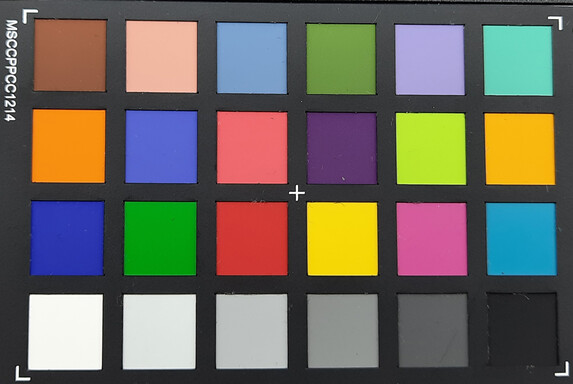
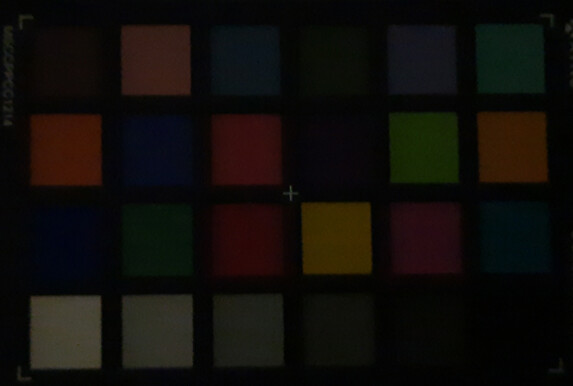
Accessories & Warranty - 2 years of warranty
In the box, there is a USB-A charger with an appropriate USB-C cable for the M21. Moreover, there is also a SIM card removal tool.
The M21 comes with a 24-month warranty.
Input Devices & Handling - Fast fingerprint sensor
There is a fingerprint scanner on the back. It is slightly recessed into the housing and its edges are raised. The initial setup is very fast and the fingerprint reader recognises fingerprints very quickly. It can also be used for gestures. For instance, if you run your finger down the fingerprint sensor you can bring down the notification shade. The M21 also supports face recognition, which works quickly and reliably.
The M21 comes with Samsung’s proprietary keyboard, which appears to be heavily inspired by Apple’s virtual keyboard. Other keyboards can be easily installed. The touchscreen works without any issues. The hardware buttons on the right side do not feel particularly premium. Nevertheless, they still work well.
Display – Bright, good screen
Samsung's lower mid-range smartphone comes with a Full HD AMOLED screen. Our measurements show that it is very similar to the display of the Samsung Galaxy M31, which is why we think that the M21 and the M31 feature the same panel.
According to our brightness measurements, the Samsung smartphone has an average screen brightness of 614 cd/m². The brightness is very evenly distributed. Because individual OLED pixels can completely switch off, the screen has a black value of 0 cd/m². This is why dark tones appear very deep.
| |||||||||||||||||||||||||
Brightness Distribution: 95 %
Center on Battery: 617 cd/m²
Contrast: ∞:1 (Black: 0 cd/m²)
ΔE ColorChecker Calman: 2.11 | ∀{0.5-29.43 Ø4.78}
ΔE Greyscale Calman: 2.6 | ∀{0.09-98 Ø5}
141.3% sRGB (Calman 2D)
Gamma: 2.073
CCT: 6921 K
| Samsung Galaxy M21 Super AMOLED, 2340x1080, 6.4" | Sony Xperia L4 IPS, 1680x720, 6.2" | Oppo A72 IPS LCD, 2400x1080, 6.5" | Samsung Galaxy A41 Super AMOLED, 2400x1080, 6.1" | Xiaomi Redmi Note 9S IPS, 2400x1080, 6.7" | |
|---|---|---|---|---|---|
| Screen | -103% | -100% | -18% | -46% | |
| Brightness middle (cd/m²) | 617 | 429 -30% | 505 -18% | 554 -10% | 622 1% |
| Brightness (cd/m²) | 614 | 404 -34% | 482 -21% | 559 -9% | 612 0% |
| Brightness Distribution (%) | 95 | 92 -3% | 93 -2% | 92 -3% | 94 -1% |
| Black Level * (cd/m²) | 0.26 | 0.55 | 0.56 | ||
| Colorchecker dE 2000 * | 2.11 | 6.14 -191% | 6.3 -199% | 2 5% | 3.98 -89% |
| Colorchecker dE 2000 max. * | 3.41 | 10.51 -208% | 10.1 -196% | 7.7 -126% | 7.33 -115% |
| Greyscale dE 2000 * | 2.6 | 6.6 -154% | 6.8 -162% | 1.6 38% | 4.5 -73% |
| Gamma | 2.073 106% | 2.23 99% | 2.29 96% | 2.11 104% | 2.206 100% |
| CCT | 6921 94% | 8346 78% | 8161 80% | 6589 99% | 7361 88% |
| Contrast (:1) | 1650 | 918 | 1111 | ||
| Color Space (Percent of sRGB) (%) | 114.9 |
* ... smaller is better
Screen Flickering / PWM (Pulse-Width Modulation)
| Screen flickering / PWM detected | 215.5 Hz | ||
The display backlight flickers at 215.5 Hz (worst case, e.g., utilizing PWM) . The frequency of 215.5 Hz is relatively low, so sensitive users will likely notice flickering and experience eyestrain at the stated brightness setting and below. In comparison: 53 % of all tested devices do not use PWM to dim the display. If PWM was detected, an average of 8108 (minimum: 5 - maximum: 343500) Hz was measured. | |||
Our CalMAN test reveals good grayscale performance. However, the Delta E 2000 colour deviations are quite significant, especially when it comes to the red part of the spectrum. The colour reproduction improves in Natural
mode. The colour space coverage is on a good level for a smartphone in this price range. Nevertheless, we have to mention that in this instance our measurements should be viewed as indications of real-life performance.
Display Response Times
| ↔ Response Time Black to White | ||
|---|---|---|
| 8 ms ... rise ↗ and fall ↘ combined | ↗ 5 ms rise | |
| ↘ 3 ms fall | ||
| The screen shows fast response rates in our tests and should be suited for gaming. In comparison, all tested devices range from 0.1 (minimum) to 240 (maximum) ms. » 21 % of all devices are better. This means that the measured response time is better than the average of all tested devices (20.2 ms). | ||
| ↔ Response Time 50% Grey to 80% Grey | ||
| 10 ms ... rise ↗ and fall ↘ combined | ↗ 5 ms rise | |
| ↘ 5 ms fall | ||
| The screen shows good response rates in our tests, but may be too slow for competitive gamers. In comparison, all tested devices range from 0.165 (minimum) to 636 (maximum) ms. » 22 % of all devices are better. This means that the measured response time is better than the average of all tested devices (31.6 ms). | ||
There is a noticeable drop in brightness when the device is viewed at extreme angles. However, it appears much more pronounced in photographs than in real life. The Galaxy M21 is usable outside on cloudy days. In direct sunlight, the screen content is difficult to read. Howbeit, the display is bright enough for many light-filled rooms.
Performance – Too slow for a device in this price range
The Samsung Exynos 9611 is a solid choice for a lower mid-range smartphone. However, it is beaten by the Qualcomm Snapdragon 720G. The MediaTek SoC in the Samsung Galaxy A41 is also faster.
The Exynos 9611 offers enough performance for day-to-day use. However, it struggles in very demanding applications. If you try to run several highly demanding applications at the same time, the smartphone may become completely unresponsive. That being said, the M21 is powerful enough for running simple applications.
| PCMark for Android | |
| Work performance score (sort by value) | |
| Samsung Galaxy M21 | |
| Sony Xperia L4 | |
| Oppo A72 | |
| Samsung Galaxy A41 | |
| Xiaomi Redmi Note 9S | |
| Average Samsung Exynos 9611 (5777 - 6697, n=7) | |
| Work 2.0 performance score (sort by value) | |
| Samsung Galaxy M21 | |
| Sony Xperia L4 | |
| Oppo A72 | |
| Oppo A72 | |
| Samsung Galaxy A41 | |
| Xiaomi Redmi Note 9S | |
| Average Samsung Exynos 9611 (5080 - 5925, n=7) | |
| GFXBench 3.0 | |
| on screen Manhattan Onscreen OGL (sort by value) | |
| Samsung Galaxy M21 | |
| Oppo A72 | |
| Samsung Galaxy A41 | |
| Xiaomi Redmi Note 9S | |
| Average Samsung Exynos 9611 (15 - 24, n=7) | |
| Average of class Smartphone (18 - 166, n=157, last 2 years) | |
| 1920x1080 1080p Manhattan Offscreen (sort by value) | |
| Samsung Galaxy M21 | |
| Oppo A72 | |
| Samsung Galaxy A41 | |
| Xiaomi Redmi Note 9S | |
| Average Samsung Exynos 9611 (17 - 26, n=7) | |
| Average of class Smartphone (12 - 606, n=156, last 2 years) | |
| GFXBench 3.1 | |
| on screen Manhattan ES 3.1 Onscreen (sort by value) | |
| Samsung Galaxy M21 | |
| Oppo A72 | |
| Samsung Galaxy A41 | |
| Xiaomi Redmi Note 9S | |
| Average Samsung Exynos 9611 (8.9 - 14, n=7) | |
| Average of class Smartphone (11 - 166, n=157, last 2 years) | |
| 1920x1080 Manhattan ES 3.1 Offscreen (sort by value) | |
| Samsung Galaxy M21 | |
| Oppo A72 | |
| Samsung Galaxy A41 | |
| Xiaomi Redmi Note 9S | |
| Average Samsung Exynos 9611 (10 - 16, n=7) | |
| Average of class Smartphone (8.4 - 413, n=156, last 2 years) | |
| AnTuTu v8 - Total Score (sort by value) | |
| Samsung Galaxy M21 | |
| Oppo A72 | |
| Samsung Galaxy A41 | |
| Xiaomi Redmi Note 9S | |
| Average Samsung Exynos 9611 (152185 - 187087, n=7) | |
In the browser benchmarks, the Galaxy M21 does very poorly when compared to other competing devices. However, in day-to-day use, the scrolling is relatively smooth and webpages do not take forever to load.
| Jetstream 2 - 2.0 Total Score | |
| Average of class Smartphone (23.8 - 387, n=149, last 2 years) | |
| Xiaomi Redmi Note 9S (Chrome 81) | |
| Samsung Galaxy A41 (Chrome 83.0.4103.101) | |
| Samsung Galaxy M21 (Chrome 85) | |
| Average Samsung Exynos 9611 (27.5 - 30.6, n=7) | |
| Oppo A72 (Chrome 83) | |
| JetStream 1.1 - Total Score | |
| Xiaomi Redmi Note 9S (Chrome 81) | |
| Samsung Galaxy A41 (Chrome 83.0.4103.101) | |
| Average Samsung Exynos 9611 (47.5 - 51.9, n=7) | |
| Samsung Galaxy M21 (Chrome 85) | |
| Speedometer 2.0 - Result 2.0 | |
| Average of class Smartphone (15.2 - 643, n=122, last 2 years) | |
| Xiaomi Redmi Note 9S (Chome 81) | |
| Average Samsung Exynos 9611 (26.6 - 30.5, n=7) | |
| Oppo A72 (Chrome 83) | |
| Samsung Galaxy A41 (Chrome 83.0.4103.101) | |
| Samsung Galaxy M21 (Chome 85) | |
| WebXPRT 3 - Overall | |
| Average of class Smartphone (38 - 380, n=31, last 2 years) | |
| Xiaomi Redmi Note 9S (Chrome 81) | |
| Samsung Galaxy M21 (Chrome 85) | |
| Average Samsung Exynos 9611 (46 - 57, n=7) | |
| Samsung Galaxy A41 (Chrome 83.0.4103.101) | |
| Oppo A72 (Chrome 83) | |
| Octane V2 - Total Score | |
| Average of class Smartphone (2228 - 121337, n=197, last 2 years) | |
| Xiaomi Redmi Note 9S (Chrome 81) | |
| Samsung Galaxy A41 (Chrome 83.0.4103.101) | |
| Samsung Galaxy M21 (Chrome 85) | |
| Average Samsung Exynos 9611 (7442 - 10687, n=7) | |
| Oppo A72 (Chrome 83) | |
| Mozilla Kraken 1.1 - Total | |
| Average Samsung Exynos 9611 (4332 - 6212, n=7) | |
| Samsung Galaxy M21 (Chrome 85) | |
| Oppo A72 (Chrome 83) | |
| Samsung Galaxy A41 (Chrome 83.0.4103.101) | |
| Xiaomi Redmi Note 9S (Chrome 81) | |
| Average of class Smartphone (257 - 28190, n=154, last 2 years) | |
* ... smaller is better
In the storage benchmarks, the Samsung smartphone achieves very good write speeds, thanks to its UFS 2.1 memory. All in all, the M21 offers good data transfer rates for a device in this price range. Having said that, the Huawei P30 Lite New Edition offers even faster storage.
With our reference-grade microSD card Toshiba Exceria Pro M501, the Samsung smartphone manages to achieve good write and read speeds.
| Samsung Galaxy M21 | Sony Xperia L4 | Oppo A72 | Samsung Galaxy A41 | Xiaomi Redmi Note 9S | Average 64 GB UFS 2.1 Flash | Average of class Smartphone | |
|---|---|---|---|---|---|---|---|
| AndroBench 3-5 | -30% | -8% | -15% | 1% | 1% | 382% | |
| Sequential Read 256KB (MB/s) | 487.8 | 293.4 -40% | 504 3% | 299.9 -39% | 496.6 2% | 696 ? 43% | 2228 ? 357% |
| Sequential Write 256KB (MB/s) | 192.7 | 165 -14% | 234.6 22% | 211.1 10% | 214.8 11% | 224 ? 16% | 1852 ? 861% |
| Random Read 4KB (MB/s) | 126 | 61.2 -51% | 135.9 8% | 84 -33% | 137 9% | 137.2 ? 9% | 296 ? 135% |
| Random Write 4KB (MB/s) | 124.2 | 22.5 -82% | 152.9 23% | 72.5 -42% | 123.6 0% | 84.7 ? -32% | 339 ? 173% |
| Sequential Read 256KB SDCard (MB/s) | 77.9 ? | 83.5 ? 7% | 37.76 ? -52% | 83 ? 7% | 74.5 ? -4% | 68.6 ? -12% | |
| Sequential Write 256KB SDCard (MB/s) | 62.2 ? | 62.5 ? 0% | 31.2 ? -50% | 67 ? 8% | 54.9 ? -12% | 52.2 ? -16% |
Gaming – Only for simple games
We use Gamebench
to record frame rates for our gaming benchmarks. In Armajet
, the M21 manages to hit 60 FPS some of the time. The M21 struggles in more demanding titles such as PUBG Mobile
. Here, the Samsung smartphone cannot achieve playable frame rates with the HD preset. However, on the lowest settings, PUBG Mobile
is somewhat playable.
Our review device is suited for simple games. Those who want to play graphically demanding titles will need a smartphone with more gaming performance.
Emissions – Fluctuating performance under load
Temperature
The area around the front-facing camera gets hottest under load. The maximum surface temperature of 42.5 °C (108.5 °F) is quite reasonable, as long as you are in an environment with a normal ambient temperature. The smartphone can become unpleasant to use on hot summer days. However, the M21 is always cool when idle.
We use a battery testing utility known as GFXBench
to examine how well our review device performs under continuous load. Here, we observed fluctuations in performance of up to 25%. All in all, the M21 fails to maintain its full performance in the GFXBench benchmark.
(±) The maximum temperature on the upper side is 42.5 °C / 109 F, compared to the average of 35.2 °C / 95 F, ranging from 21.9 to 247 °C for the class Smartphone.
(+) The bottom heats up to a maximum of 39.2 °C / 103 F, compared to the average of 34 °C / 93 F
(+) In idle usage, the average temperature for the upper side is 27.8 °C / 82 F, compared to the device average of 32.9 °C / 91 F.
Speakers
The mono-speaker on the bottom offers a mediocre volume. However, it has no trouble reproducing voices. The high tones are significantly overrepresented, because the lows and the mids are almost completely missing. At maximum volume, the speaker sounds unpleasantly tinny.
For a better listening experience, we recommend you use a set of headphones, which can be connected to the device via either the 3.5-mm audio jack or Bluetooth 5.0. The headphone jack offers a low level of background noise. The Bluetooth connection is stable and easy to establish and the audio quality is quite good.
Samsung Galaxy M21 audio analysis
(+) | speakers can play relatively loud (83.8 dB)
Bass 100 - 315 Hz
(-) | nearly no bass - on average 69% lower than median
(+) | bass is linear (0% delta to prev. frequency)
Mids 400 - 2000 Hz
(-) | nearly no mids - on average 69% lower than median
(+) | mids are linear (0% delta to prev. frequency)
Highs 2 - 16 kHz
(-) | nearly no highs - on average 69% lower than median
(+) | highs are linear (0% delta to prev. frequency)
Overall 100 - 16.000 Hz
(-) | overall sound is not linear (119.9% difference to median)
Compared to same class
» 89% of all tested devices in this class were better, 8% similar, 3% worse
» The best had a delta of 11%, average was 35%, worst was 134%
Compared to all devices tested
» 97% of all tested devices were better, 3% similar, 1% worse
» The best had a delta of 4%, average was 24%, worst was 134%
Samsung Galaxy A41 audio analysis
(+) | speakers can play relatively loud (85.5 dB)
Bass 100 - 315 Hz
(-) | nearly no bass - on average 27.8% lower than median
(±) | linearity of bass is average (14.4% delta to prev. frequency)
Mids 400 - 2000 Hz
(±) | higher mids - on average 5.9% higher than median
(+) | mids are linear (5.8% delta to prev. frequency)
Highs 2 - 16 kHz
(±) | higher highs - on average 9.7% higher than median
(±) | linearity of highs is average (7.2% delta to prev. frequency)
Overall 100 - 16.000 Hz
(±) | linearity of overall sound is average (27.2% difference to median)
Compared to same class
» 70% of all tested devices in this class were better, 6% similar, 24% worse
» The best had a delta of 11%, average was 35%, worst was 134%
Compared to all devices tested
» 83% of all tested devices were better, 4% similar, 14% worse
» The best had a delta of 4%, average was 24%, worst was 134%
Battery Life - Large battery with good runtimes
Energy Consumption
The Samsung Galaxy M21 is not particularly energy-efficient. However, the Galaxy M31 is even less energy-efficient. The Xiaomi Redmi Note 9S has a higher power draw when idle, but it consumes less energy under load.
| Off / Standby | |
| Idle | |
| Load |
|
Key:
min: | |
| Samsung Galaxy M21 6000 mAh | Oppo A72 5000 mAh | Samsung Galaxy A41 3500 mAh | Xiaomi Redmi Note 9S 5020 mAh | Average Samsung Exynos 9611 | Average of class Smartphone | |
|---|---|---|---|---|---|---|
| Power Consumption | 20% | 29% | -8% | -11% | 3% | |
| Idle Minimum * (Watt) | 1.2 | 0.7 42% | 0.96 20% | 1.5 -25% | 1.173 ? 2% | 0.842 ? 30% |
| Idle Average * (Watt) | 1.8 | 1.97 -9% | 1.57 13% | 2.1 -17% | 2.28 ? -27% | 1.439 ? 20% |
| Idle Maximum * (Watt) | 2.1 | 1.98 6% | 1.61 23% | 2.5 -19% | 2.86 ? -36% | 1.624 ? 23% |
| Load Average * (Watt) | 6.2 | 3.83 38% | 2.93 53% | 5.2 16% | 5.97 ? 4% | 7.03 ? -13% |
| Load Maximum * (Watt) | 7.9 | 6.2 22% | 4.97 37% | 7.5 5% | 7.83 ? 1% | 11.3 ? -43% |
* ... smaller is better
Battery Life
Samsung’s Exynos SoCs are not known for their efficiency. However, thanks to a 6000-mAh battery, the M21 should last for a long time. In our Wi-Fi test, the M21 achieves a stellar battery runtime of over 21 hours. Here, the Galaxy M31 does slightly better. That being said, no other competing device comes even close to reaching such a great battery runtime. The smartphone can easily last three work days before it dies.
The 6000-mAh battery takes more than two hours to fully charge with the included 15-watt charger.
| Samsung Galaxy M21 6000 mAh | Sony Xperia L4 3580 mAh | Oppo A72 5000 mAh | Samsung Galaxy A41 3500 mAh | Xiaomi Redmi Note 9S 5020 mAh | |
|---|---|---|---|---|---|
| Battery runtime | -39% | -21% | -26% | -5% | |
| Reader / Idle (h) | 38.3 | 30.7 -20% | 37.7 -2% | ||
| H.264 (h) | 22.5 | 16.6 -26% | 21.2 -6% | ||
| WiFi v1.3 (h) | 21.6 | 13.1 -39% | 17 -21% | 10.8 -50% | 19.8 -8% |
| Load (h) | 4.8 | 4.5 -6% | 4.7 -2% |
Pros
Cons
Verdict – For those who are looking for something solid
The Samsung Galaxy M21 offers a mediocre camera system and a mediocre level of performance. Other manufacturers are chasing specs and putting emphasis on the camera performance. Samsung just builds solid smartphones, which have no weaknesses and offer a couple of special features on top.
The Galaxy M21 is in the exact place, which much more expensive smartphones with very good battery life and bright OLED screens used to occupy.
The Samsung Galaxy M21 is a rock solid, lower mid-range smartphone with a great screen and good battery life.
As we mentioned before, the M21 has very few weaknesses, all of which can be attributed to the simple fact that Samsung chose to use its proprietary Exynos SoC: It is not as energy-efficient or powerful as the SoCs from the competition, but it still offers a rather decent level of performance.
In day-to-day use, the Galaxy M21 is all right, and it brings to the table everything that a smartphone in this price range should.
Samsung Galaxy M21
- 08/31/2022 v7 (old)
Florian Schmitt




